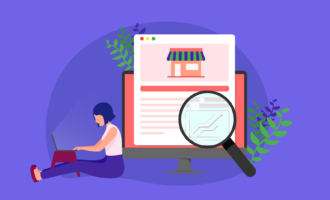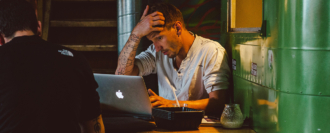When I was a kid, I worked in my cousin’s gift store.
I was so bored during those long, hot summers that I didn’t even ask him to pay me.
But one day I had a brilliant idea. I would go into the hills, pick figs from local gardens, and sell them to tourists.
I shared this plan with my cousin.
“That’s a terrible idea,” he said, shaking his head. “Everyone will ask where you got them from. You’ll just be a thief.”
It was my first business idea — and it failed before it even started.
Many people believe that successful entrepreneurs are born to take risks.
Either you were an eight-year-old with a lemonade stand or you don’t have the right stuff.
As the late Victor Kiam — the former president of Remington and owner of the New England Patriots — once said:
“Entrepreneurs are risk-takers, willing to roll the dice with their money or reputation on the line in support of an idea or enterprise.”
I disagree. I’m not fearless and I don’t take risks.
In fact, not being a risk-taker:
- Has enabled me to build a business with over 110 employees
- Allows my startup, Jotform, to serve nearly 4 million users
- Explains why I still own 100% of my business
- Underlies our great company culture
To understand what I mean, let me share my story — and how my experiences can strengthen your business, too.
1. Learn on someone else’s dime (and time)
In a 2015 study, 72% of U.S. high school students said they wanted to start a business.
Over 60% planned to start their business right out of college.
That’s a lot of teenagers moving straight from the classroom to (hopefully) the boardroom. And for some, it’s the right step.
I also think there’s so much to learn before leaping into entrepreneurship.
When I was in college, I built a membership tool for our student organization. I thought other people might also want to use it, so I released it as an open-source product. Eventually, people started paying me for customizations.
I was thrilled to earn money doing work I loved, so I spent the winter break of my senior year building a paid version.
When that product started to bring in real cash, I was hooked. I knew I would start a business — but first, I would find a full-time job.
So, I spent five years writing code for a New York media company. I learned so much during that time, from work processes to collaboration to management styles to how gossip travels through organizations.
All those experiences still help me today — and I gained the knowledge risk-free.
With my salary paid, I could keep building my product in the off-hours. Only my time and energy were on the line.
Bottom line:
You don’t have to take risks to build a successful business. Learn on someone else’s dime (and time) first.
Building your business on the side can relieve real financial pressure. And, if you work full-or part-time, you can apply what you learn to your business.
Just try to do something (even if it’s a volunteer position) that hones your skills and deepens your knowledge.
For example, if you want to launch an online publication, try to get inside an editorial department or do media sales.
2. Use what you have
- MailChimp
- Lynda
- Shopify
- GoFundMe
- Tough Mudder
- ShutterStock
What do these companies have in common? They were all bootstrapped into multi-million-dollar valuations (even if they later took funding).
The startup world gets so buzzy about VC money that it’s easy to forget about bootstrapping.
It’s not always possible, but for many people, it’s a great option.
When you bootstrap your idea, you can take your time and stay in the driver’s seat without any pressure from investors.
Take me as an example.
I saw the need for online web forms while I was working in New York.
After I quit, I spent six months building JotForm. I released the free version in 2006 — and it was a true MVP. It only had basic functions. I wanted to see if people would like it or use it.
If it failed, I had only invested six months of my time and energy, and I still had the side product income to keep me afloat. I leveraged what I had.
Once I hired our first employee, we spent another year building the premium version. By the end of 2007, we had 500 paying customers.
Over the last 12 years, we’ve continued to grow from that foundation. We have no debt and we’ve never taken a penny in outside investment.
Bottom line:
Use the resources you have, no matter how modest they are. It’s amazing what’s possible when you identify a problem and solve it for others.
Also, take your time. Don’t worry about hockey stick growth charts or press coverage. Keep working, keep learning, and be patient.
Perseverance will take you far.
3. Concentrate on one thing at a time
Focus is a magical word. It’s also the secret to sustainable growth.

As author and consultant Chris Zook explains:
“At first blush, narrowing the focus to grow sounds almost counterintuitive. But just as plants often must be cut back to concentrate their energy on fewer, stronger branches, so too, businesses must be pruned to counter their tendency to branch out more than they should.”
In some ways, Jotform is a boring company. We create online forms.
But, we try to do it really, really well. It’s all we do — and we’re constantly trying to improve how we serve our customers.
I know that might sound like marketing 101 or a generic PR line.
Yet, it can be surprisingly difficult to focus on one thing, especially when you start to gain traction. New opportunities pop up. Everyone has endless, and often contradictory, ideas about what you should do next.
That’s when you have to get ruthless and stay the course.
Bottom line:
Maintain your focus. Go deeper, not broader.
If you try to do many different things, your time and energy is fragmented. You risk the success of your core idea.
I’m not saying you shouldn’t evolve or listen to the market, but try not to get distracted.
A singular focus is a smart way to avoid risk.
4. Remember that cash flow is queen
Quarterly earnings, tax brackets, user acquisition rates, page views, market reach.
These are all important details. Every business has to pay taxes and track key numbers.
I’ve always worked with an accountant, but until recently, I managed our cash flow.
Here’s what I looked for:
Is our bank account growing?
I don’t mean to undermine real (and potentially valuable) cash flow analysis systems, but sustainable growth can be this simple:
Are you profitable?
Are you earning more than you spend?
Is the money in your bank account increasing, staying the same, or decreasing?
Some companies make three-year sales predictions and hire (or fire) staff based on those numbers. I’ve never had that mindset.
Maybe we could have grown a lot faster, but I’ve never been stressed about money. I usually sleep well at night.
Our sales typically increase by 50% every year. That’s how we’ve achieved steady growth — and I still won’t hire a new employee unless we have a full year of their salary in the bank.
There’s no risk involved.
Bottom line:
Your growth depends on your revenue. Don’t increase your team or your expenses until your sales rise. Watch your cash flow and work within your means.

5. Remember your roots
In 2010, Alli Webb opened Drybar — a hair salon that only offers wash-and-blow-dry services. Today, Drybar has over 100 locations across the U.S. and Canada.
The company has faced tough competition, but they’ve succeeded by providing an exceptional experience for everyone who visits.
Like I mentioned above, they focus on one thing and do it really, really well.
Most importantly, Drybar hasn’t strayed from its core mission. As Webb told Liz Welch in a story for Inc.:
“Many investors have said, ‘We have this captive audience. That’s a huge opportunity to sell a lot of other things.’ I’ve always resisted that — and I think it resonates… Our clients know they’re not going to be pitched to or bombarded by our stylists to buy products. It’s hard to be really great at a lot of things.”
I love Webb’s approach.
Our company is all about design and development. We’re obsessed with improving the product, not selling it. Over the years, we may have missed out on opportunities, but we’ve always stayed true to our purpose.
Growing slowly, avoiding risks, and focusing on the customer has also influenced our company culture. In the early years, there were less than five of us in the office, so we spent the whole day together.
We worked on the same projects and spoke the same language.
We’re a lot bigger now, but we’ve maintained a culture where everyone cares deeply about the product. We share the same goal. We know why we coming to work every day.
Bottom line:
Grow and evolve, but don’t lose sight of your purpose. And remember that purpose doesn’t have to start with a capital “P.”
Alli Webb wanted to give women an affordable, yet luxurious styling service. That’s still what her company does today.
6. Always share your work
According to developer and entrepreneur Jason Roberts, the amount of serendipity you experience…
“… is directly proportional to the degree to which you do something you’re passionate about combined with the total number of people to whom this is effectively communicated.”
He calls this your Luck Surface Area.
In other words, you can create and grow your own luck.
I learned this the hard way. In 2010, we decided to overhaul our form builder, which is the heart of the product.
We spent a full year perfecting it behind closed doors. We fussed and fixated and built something we thought was amazing.
When we finally released it, our users were enraged. The product was littered with bugs. We had broken the tool they relied on for their work, their organizations, and even their hobbies.
We listened closely and soon fixed our mistakes. Our team worked night and day to make it right — and to make it up to our customers.
Once the dust settled, I realized that working without feedback had been a major risk. It was probably the biggest risk I’ve ever taken.
We immediately switched to a continuous improvement model. Now our teams make changes, test them with real customers, adjust, and release. We do this weekly and sometimes even daily.
Bottom line:
Continuous improvement reduces your risk. Sharing what you’re building also increases your Luck Surface Area.
So, don’t work in a vacuum.
Let your customers, users or audience in on the process so you can keep improving.
Follow your bliss
Wait — stay with me here. Notice that I didn’t say “follow your dreams.”
Other than my failed fig-selling plan, I never dreamed of being an entrepreneur.
I didn’t imagine my face on the cover of a magazine or landing massive funding rounds.
In truth, I had no idea how to raise capital. I didn’t know what PR meant. And I’ve never been a risk-taker.
But, I’ve always loved making things. I could lose myself for hours in a coding project.
Back in 2006, I saw a need, and then the startup bug hit me. Quite honestly, being paid for my work pulled me into entrepreneurship.
Looking back, if I hadn’t started my company, I think I would have become a product manager for another organization. Writing code made me happy. That was my bliss — and it still is.
So, please know that you don’t have to be a fearless, risk-taking genius to create a successful business. You can move slowly, grow at your own pace, and learn as you go.
Success and risk-aversion can go hand in hand.
Now, go do it your way.











































































Send Comment:
8 Comments:
More than a year ago
Randomly came across your writing and love your view of taking growth slowly, and intentionally, instead of just jumping in and burning through. This is what businesses that last decades do. just signed up to use Jotform because Aytekin sounds like the type of person you want to do business with.
More than a year ago
Really glad I came across your blog, you're my new inspiration.
Thank you and best wishes for 2019.
More than a year ago
Thanks so much for writing about your style of bootstrapping and growth. This is a kind of story that rarely gets told, and many of us, like me, need the inspiration. You're my new hero man.
More than a year ago
Why does your blog post about how to handle criticism illustrated with a photo of a women looking attacked and carefully non-gendered in the text with lots of "we" but not "he" but this story on being an entrepreneur is 90% about men and features an illustration of a man? Sexist much?
More than a year ago
Great article for entrepreneur, thanks.
It helps a lot.
Rahul, Team manager at
More than a year ago
Great insight into your story and a beacon of hope for those who don't want to risk it all to start their own thing.
Kudos.
More than a year ago
Great and inspiring writing, thank you.
Just a small point: "We know why we coming to work every day." (It seems something is missing in this sentence.)
More than a year ago
I built my business the same way, and I think many entrepreneurs do the same. They just aren't noisy about it because they don't need the PR for fundraising and ego-boosting. They also don't have "cool" stories about eating catfood while they struggled, and all the trauma that makes a good movie.
Unfortunately most entrepreneurs think they are unappreciated geniuses. They want to work for a couple of years and retire. They hate the work, and don't care about the business, users or clients.
They give us all a bad name by building junk, risking and usually losing someone else's money, conning shareholders, and hiring graduates and interns to work for "glory" or non-existent shares. They rarely have any skills because they never stayed with anything long enough to learn it in depth. And they can make empy promises with great conviction because they have no idea what they are talking about.